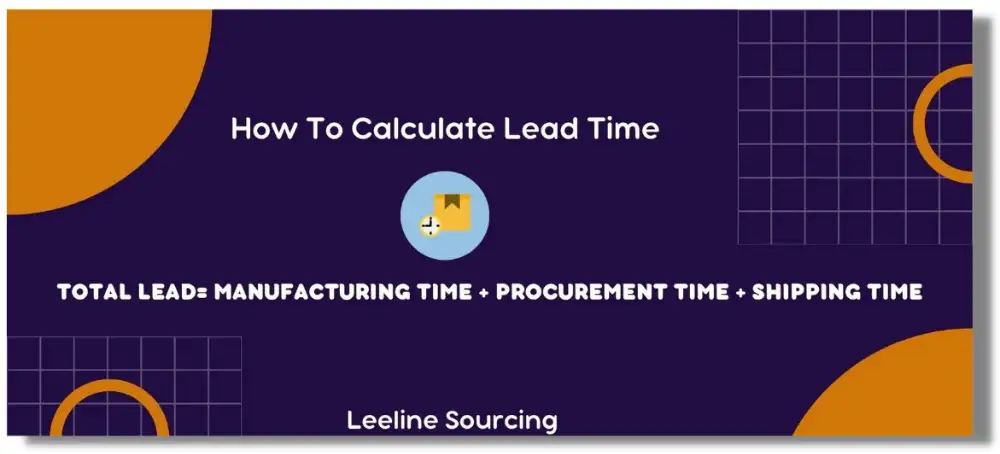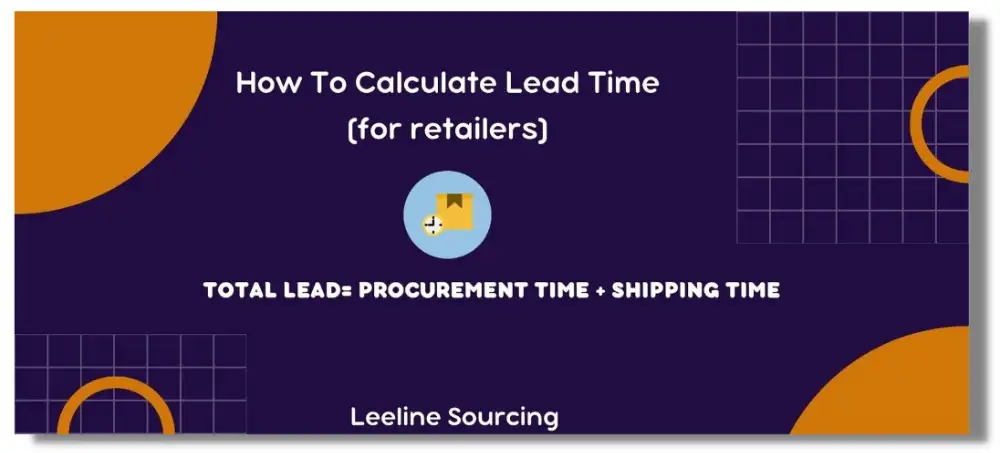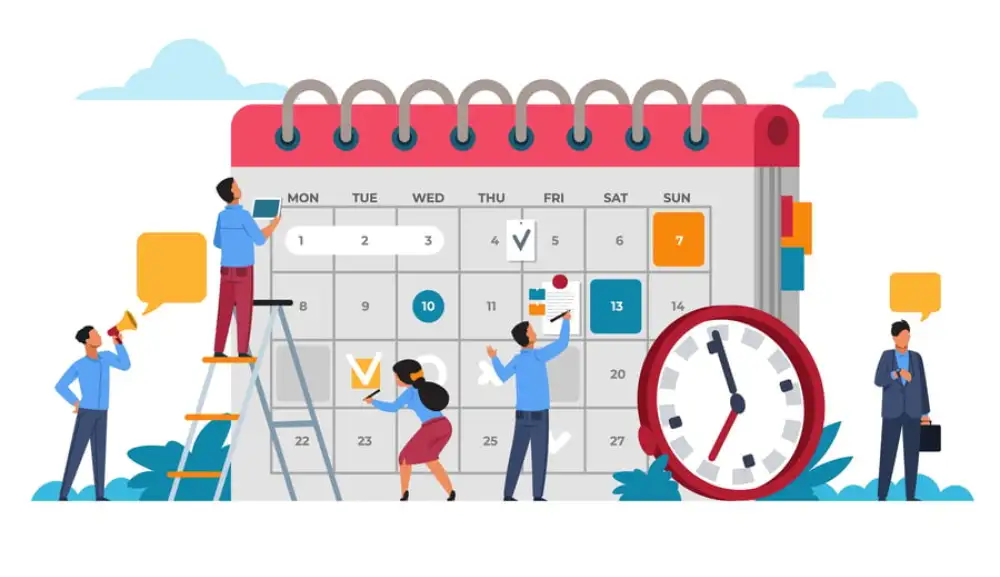Tired of reading OLD and OUTDATED lead time guides?
Today’s your lucky day…
I’m an eCommerce entrepreneur with over 10 years of industry experience of product design. And I’m going to share with you how Lead Time ACTUALLY WORKS. Plus how you can minimize it to increase your profit margins.
This guide covers how to calculate lead time. The different types of lead times. And time-proven strategies to reduce your lead times.
Let’s dive in…

Basic Understanding of Lead Time

Let us think of Lead Time as Traffic Lights on a main road.
The red light is like the Reordering point. Yellow light is like Order processing. And Greenlight is like Delivery.
Thus, lead time is the overall time for a traffic light to change from red to green.
SIMPLE!
In inventory management…
Lead time is the average time a seller takes to place and receive an order.
I can’t wait to share more details on why Lead Time is vital for your business!
But first…
Looking for the Best China Sourcing Agent?
Leeline Sourcing helps you find factories, get competitive prices, follow up production, ensure quality and deliver products to the door.
How Lead Time Works? How to Calculate It?
I started my eCommerce business in the prehistoric times. And it was HARD calculating Lead Time in my first year in operation.
It just looked like a complex math equation from my Sophomore days. And the guides and YouTube tutorials weren’t helping either.

But it shouldn’t be that confusing AT ALL! In fact, there are many ways how to calculate lead time. (just don’t get carried away cramming them all).
After months of research. I stumbled upon a simple technique on how to calculate lead time like a PRO:
For manufacturers…

“Lead Time formula for manufacturers.”
Here is an example :
Imagine you own a clothing brand, and you want to make a bulk order of 500 t-shirts. Let’s calculate the manufacturing lead time using the above formula.
Step 1. Analyze the company’s data to determine the manufacturing time. Say 500 T-shirts in 1 week.
Step 2. Determine the procurement time. (i.e., the time taken to gather all raw materials for production). Let’s assume the manufacturing company takes 6 days to gather ALL raw materials.
Step 3. Determine the total shipping time it takes to deliver goods to your location. We’ll assume it takes 3 days to ship the t-shirts to our location.
Now use the formula to calculate our cumulative lead time:
Total Lead Time = Manufacturing Time + Procurement Time + Shipping Time
Total Lead Time = One week (7 days) + 6 days + 3 days
Total Manufacturing Lead Time = 16 days
The Lead Time Calculator shows that the average lead time is 16 days. So you can use this information to reorder before you run out of stock. And ensure customers receive their goods on time. ALWAYS!!
For retailers…
Here calculating the lead time is quite simple:

“Lead Time formula for retailers.”
Still on our 500 t-shirts example:
Step 1: Determine the average procurement time for your supplier. We’ll assume our supplier takes 2 weeks to source raw materials for the production process.
Step 2: The supplier outsources a 3PL partner that ships items within 1 week.
Now let’s calculate the entire lead time:
Lead Time = Procurement Time + Shipping Time
Lead Time = 2 weeks (14 days) + 1 week (7 days)
Total Lead Time = 27 days
PRO TIP. I have saved my business thousands by prioritizing suppliers with minimal lead times. My customers receive their orders on time. And I never have to worry about a halted supply chain. EVER.
Types of Lead Time

Here are the MOST common Lead Times in Inventory Management today:
1. Material Lead Time
Yes, we briefly covered this in the previous section, but allow me to reiterate:
Material Lead Time is the time it takes to source raw materials for a product. Manufacture. And ship it to the end consumer.
Oh, and I almost forgot to mention it involves packaging and quality control.
One hindrance to EFFECTIVE material lead time delays in acquiring raw materials. It can GREATLY increase the entire manufacturing process. And hinder overall customer satisfaction.
2. Production Lead Time
It is the amount of time it takes to complete the production process of a certain product.
Also, production lead time has a vital role to play in a company’s manufacturing process. That’s because it dictates the company’s ability to deliver products on time. Meet customer demand. And improve customer satisfaction.
Production Lead Time is GREATLY affected by production capacity and raw materials.
For example:
Inadequate machinery or skilled labor will lead to increase in production lead time.
3. Delivery Lead Time
It simply refers to the time it takes for an order to arrive at the customer’s location.
Delivery Lead Time delays are mainly caused by longer shipping distances. Use of slow shipping times. Or TEDIOUS customs clearance procedures for international shipments.
4. Cumulative Lead Time
Cumulative Lead Time is the total duration it takes to produce a product. (from order placement to delivery).
It encompasses ALL processes involved in material, production, and delivery lead times.
Again, it involves customization, regulatory approval, testing, and certification.
Some internal factors that affect FAST cumulative lead time. These include delays in order processing. Vague quality control processes and inadequate production capacities.
5. Customer Lead Time
Customer lead time is the time from when the customer places an order. To when they receive it.
Customer Lead Time is generally affected by disrupted supply chain management processes. Delays in shipping. Or human error.
Why Is Lead Time Important to Business?

Today self-proclaimed eCommerce gurus don’t talk about the importance of lead time. Simply because they don’t understand it. Or they’ve NEVER heard of it.
But the truth is that…
Prioritizing shorter Lead Times is the missing piece to hitting that 7-figure profit.
Here’s why:
Customer Satisfaction
Imagine it’s a chilly Saturday afternoon.
You are cracking your skull open brainstorming an idea for your dropshipping biz.
BAM💡 – your next BEST SELLER:

I’m about to make SO MUCH MONEY! Woohoo! …Dubai, is that you? (**packs summer shorts in a travel bag**).
You hop onto Alibaba. You know, the usual. Fail to check the estimated delivery time. Blindly add items to your cart. And hit that order icon.
Let the waiting games begin…
Two weeks. Three weeks. Four weeks. Five weeks. Six weeks. Seve…
BEEN THERE. EXPERIENCED THAT. GIVE ME BACK MY MONEY!
Now imagine that’s the same experience your customers go through on your website. Good luck making that $500 in your first month.
Don’t believe me? Here’s a customer whose fed up with a slow shipping process:

OR.
You should focus on working with suppliers who offer shorter lead times. So you fulfill orders FASTER. Build customer loyalty. And enjoy repeated sales.
Competitive Edge Over your Competition
As I said before, I started my business in the prehistoric era. And the competition was MAD!
But there was one thing that stood out…
Longer lead times. They took days (even months) to deliver items to their customers. Thus, they were unable to meet the ever-rising customer demand.
So I focused on improving my customer lead time for the next few years. And I almost instantly hit the “HOLY S**T” target.
If my competitor offered 2 and a half weeks of shipping. I offered next-day delivery or same-day delivery.
And the result? 10 X sales. 10X profits. 10X everything.
And the statistics are grim: 65% of customers are willing to pay for faster delivery times.
Improved Productivity
I’ve already said it TWICE – you need to understand lead time. And how to calculate it too.
Accurate lead time calculation will help you:
- Improve supply chain management
- Streamline your project management operations
- Increase customer satisfaction
- Handle huge order volumes
- Proper resource allocation
Also, you avoid supply delay. So you are always operational. And you meet customer expectations SEAMLESSLY.
Cost Optimizations
I’ll be completely honest with you. And I’m not going to sugarcoat ANYTHING!
My first eCommerce days were pretty rough. I worked my ASS OFF with almost stupid ROIs (little to none). Plus, I was struggling with long lead times, which resulted into:
- Higher Shipping costs
- High labor costs due to production delays or inefficient supply chain management
- Additional inventory costs (e.g., Storage costs, Insurance)
I simply could avoid this by streamlining my production process. Hence, minimizing my lead time. And saving my business thousands of dollars.
I could’ve been very well at $10,000 in my first year if I understood lead time EARLIER.
Looking to find a reliable Chinese supplier?
As the best China sourcing agent, we help you find factories, get competitive prices, follow up production, ensure quality and deliver products to the door.
Lead Time Across Various Industries

There are several lead time across different industries:
Lead Time in Manufacturing
This is the duration it takes to produce a product.
Lead time in manufacturing involves:
- Order processing
- Production planning
- Packaging & customization
- Shipping and Transportation
- Order Fulfillment & Delivery
A delay in any of these processes affects the overall lead time. Including the other lead times. For example, supplier lead times and delivery lead times.
And as I said earlier, the lead time formula is quite simple. Just add the manufacturing, procurement, and the shipping time. Pretty simple, isn’t it?
Lead Time in Shipping and Logistics
It is simply the time taken for a product to arrive at the customer’s final destination. (from the seller/supplier/manufacturer).
Lead Time in shipping and Logistics MAINLY involves:
- Order processing
- Picking appropriate shipping carriers
- Customs clearance
- Transit times
- Final delivery
An in-depth understanding of shipping policies in different countries is critical. Plus, the shipping company should analyze supply times to avoid shipping delays. Thus, missing important delivery deadlines.
Shipping companies MUST understand the time it takes to deliver products to customers. And work EFFICIENTLY to meet the customer’s order time.
Lead Time in Project Management

It is the time it takes between the initiation of a project to its completion.
Lead Time in Project Management shows YOU how long it takes. For the production of the product to be complete.
But don’t confuse it with lag time, as I see most sellers doing.
Lag time is strictly the time that passes before another project begins. (or the production of a new product starts).
Lead Time in Inventory Management
Now this is quite confusing.
But I’ll try to make it VERY simple.
Lead time in inventory management is the time it takes to reorder inventory. And it’s delivery.
Most eCom-preneurs really mess up when calculating this lead time. Because of multiple lead time components.
Here’s what I mean:
It involves calculating a bunch of other lead times. That includes supplier lead time, manufacturing lead time, etc.
Remember, you still have to deal with seasonal demand fluctuation. So suppliers might actually get overwhelmed with an increase in demand.
Understanding how to calculate lead time in inventory management is vital. For the success of your online business.
Lead Time in Procurement
It refers to the time from initiating the order request to when you receive your items.
Lead time in procurement involves:
- Sourcing suppliers
- Order processing
- Manufacturing and processing
- Delivery
It is key to effective planning, collaborating with suppliers, and reducing stock shortages.
What Are The Factors That Affect Lead Time?

There are 7 SIGNIFICANT factors that affect Lead Time:
Delays in the manufacturing process
Businesses often experience longer lead times due to equipment delays. Or Insufficient production capacity.
For Instance:
A machine breakdown will stop the ENTIRE production process until a repair is made.
While a power outage slows down the manufacturing process. Thus, limiting a company’s production capacity. And impeding faster lead times.
I’m the kind of guy that likes Streamlining my production processes. To avoid manufacturing delays. I’ve had to automate my processes and conduct regular capacity checks. (#GOODBYE PRODUCTION DELAYS).
Supplier and shipping disruptions
This is a very common factor that affects lead time.
Supplier disruptions are often due to shipping delays or quality issues.
Shipping disruptions are pretty unavoidable. They include labor strikes, carrier breakdowns, or port congestion.
Still don’t believe me? Check out this Cargo ship. Who even knew this ship would sink just hours after departure? I didn’t! The crew didn’t. And you? Of course, You DIDN’T!

I recommend collaborating with several suppliers to avoid such disruptions. (That may suck your business dry!). Or partnering with ONLY RELIABLE suppliers.
Again, try to maintain clear communication channels with your suppliers. So you minimize these disruptions and shorten lead time.
Inadequate raw materials and labor shortages
Let’s face it: You can’t produce ANYTHING without raw materials. And with no professionals to bring your design to life. Your idea is as good as DEAD!
Stock shortages (in the supply chain) can disrupt the entire manufacturing lead time. Thus, causing longer lead times.
You can avoid this by:
- Find other sourcing partners. (Our company will help you build a GREAT portfolio of Chinese suppliers).
- Train employees on handling stock shortages
- Create a contingency plan
That way, you never stress over inadequate raw materials. And stand out in a huge way during harsh economic times.
Natural Disasters
Get this – Natural disasters are unavoidable.
They are unexpected and HIGHLY destructive. And cause uncertainty with longer lead times than other factors on this list.
Natural disasters such as earthquakes can delay acquiring raw materials. Thus, prolonging the production process and affecting accurate lead times.
Here’s my hack on avoiding the impact of natural disasters:
I store my items in different warehouses across the country. That way, when Shanghai is facing ADVERSE weather conditions. I just contact my guy in Beijing or Hong Kong and ship my products from that location. No need to cancel orders or issue refunds.
LIFE HACK!
Holidays
Public holidays can disrupt normal business operations by reducing the workforce. Or cause a decline in customer demand patterns.
I mean, who doesn’t like holidays? ( I can’t wait for the Mooncake Festival!)
The result? Significant strain on a company’s production capacity. And prolong the predicted lead times.
Also, employees taking time off during holidays slow the manufacturing or delivery process. Further, prolonging lead times.
You can plan in advance to shorten the lead times. Record any future holidays (especially Chinese ones).
Oh, and don’t forget to clear any pending deliveries.
A sudden increase in demand

A spike in demand causes longer lead times. That’s because most companies don’t have enough inventory to meet it.
EXPERT ADVICE. Companies should increase their production capacities. Adjust production schedules. Or acquire additional resources to curb unexpected surges in demand.
Wait…hold on!
Companies should AVOID rapidly scaling their production to meet the increase in demand.
That way, they avoid straining their production capacity. Supply chain disruptions. And prevent workforce-related challenges.
Procurement
Let’s have a look at the processes involved in the procurement stage:
- Finding RELIABLE suppliers
- Negotiate affordable rates
- Inventory management
Delays due to sourcing high-quality products can affect the above processes. Resulting to longer lead times.
Again, failure to find trustworthy suppliers will prolong the procurement stage. And further, increase the lead time.
Streamlining your procurement operations is a GREAT way to reduce such challenges. Thus, in turn, SHORTEN the lead limes.
A Fast , Easy and Cheap Way to Ship from China
Do not hesitate to contact Leeline Sourcing at any time regarding your shipments from China.
Strategies to Reduce Lead Times

I’ll keep it at 100 with you. You won’t always have FULL control over your lead times. Plus, other factors, like natural disasters, are just beyond our control.
But still…you can implement structures to mitigate longer lead times TODAY.
Here are my TOP 5 proven strategies for reducing lead times:
Source items locally
I rarely source my products from overseas.
Years back, I discovered that I IMMENSELY reduced my lead times by sourcing locally. That’s because I don’t have to wait for months for International customs clearance.
Plus, most local suppliers are easily accessible. So the communication channels are more clear and concise. And their return policies are QUICKER.
Again, I find it generally easier to build long-term relationships with local suppliers. That way, you foster trust and reliability and reduce the risk of disappointments.
Lastly, working with local suppliers eliminates language barriers. Promoting effective communication and eliminating potential delays.
Practice contingency planning
This is a PERFECT way to cushion your business. From prolonged lead times due to natural disasters or spikes in demand.
“Without a clear plan and a well-thought-out strategy, success is difficult to achieve. Planning is not optional; it’s a necessity.” – Jack Ma in reference to the success of Alibaba.
Developing contingency plans help you reduce lead times during uncertain times.
You can start by having a portfolio of backup suppliers. Or maintaining safety stocks to mitigate a decline in production.
That way, you ALWAYS fulfill customers’ orders on time. And cash in the extra $1000 even on the rough days.
Streamline processes
I’m a BIG fan of optimizing internal processes. That involves a lotta things, including:
- In-depth analysis of your workflow
- Assessing potential bottlenecks and making improvements
- Automating tasks for complex processes (e.g., data analysis, order tracking)
- Adopting ERP systems and supply chain management software
…just to mention a few.
You will notice better communication among your employees. And faster processes leading to a short internal lead time.
Which brings us to…
Enhance communication and collaboration

I always give clear lead time expectations to my suppliers from the start. I NEVER beat around the bush. That way, I don’t have to ask the supplier why I haven’t received my delivery.
Also, this helps my suppliers to plan the distribution schedules in advance. So that they don’t rush to deliver a poor-quality product.
You can do this by sharing your production schedules or forecasts one month in advance. Or jumping into a quick meeting with your supplier to discuss your expectations.
You’ll enjoy a more synchronized flow of goods and quicker problem-solution. (in case of any misunderstanding).
Increase your order frequency
Here’s my favorite strategy that I use to shorten my lead times.
I used to think that making bulk purchases would save me money. Only to realize that it was affecting my lead times BIG TIME.
That’s because huge shipments require longer production processes and shipping times. Also, they cause potential delays in the supply chain.
So what now?
Just order items in smaller quantities.
- Small orders are generally easier to process
- Require less manufacturing, packaging, and shipping time
- Have minimal shipping times
Increasing your order frequency will help reduce your lead times. So you get goods to customers on the EXACT delivery date. And create a wonderful reputation for your brand.
We can Made Drop Shipping from China Easy
Leeline Sourcing is to help Shopify & small businesses sourcing products from China and build your branded business.
FAQs about Lead Time
1. What’s the difference between Takt Time, Cycle Time, and Lead Time?
Take time is the time it takes to finish the production of one unit of a product. And the beginning of the next.
Cycle time is the duration it takes to complete the production of a single unit.
Lead time refers to the time taken from receiving a customer order to its delivery date.
2. How long is the lead time for a plastic injection mold?
The lead time of a single plastic injection mold is usually around 3 to 4 weeks.
3. What are the components of lead time?
The main components of lead time include:
· Pre-processing time
· Processing
· Storage
· Transportation
· Inspection
These stages can simply be classified into pre-processing time, processing, and shipping.
4. What is the typical lead time for stock kitchen cabinets to be delivered?
Well, it varies depending on the supplier and the location of the buyer.
The standard delivery lead time for stock kitchen cabinets is between 7-14 days.
What’s Next
That’s 2,500+ words of pure bliss.
If there’s anything I want to impress on you, it’s the importance of understanding lead time.
Like we’ve said before, focus on reducing your lead times. If you want to have ANY CHANCE in this competitive eCommerce space.
If you don’t, then don’t complain why you are investing thousands of dollars with ZERO returns.
Are you looking for a reliable Chinese supplier with GREAT lead times? Or do you want to find your next winning product? Send us an email on our contact pages. And our sales professionals will contact you SHORTLY.
Related Resources
Ecommerce Business Guide
Do you want a successful import business?

Hey, I’m Sharline, co-founder of LeelineSourcing. We’ve helped 2000+ customers import from China.
Do you want a better price on product or shipping?








